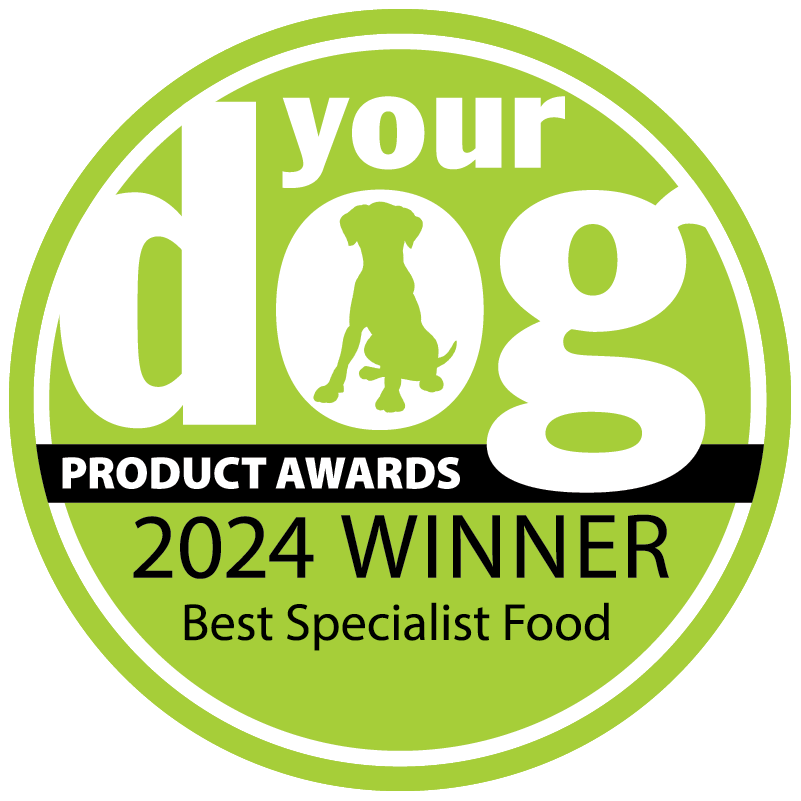
Hypoallergenic dog food technical definition
Differences between a dog food allergy and a dog food intolerance
Symptoms of adverse food reactions
Help your dog avoid an adverse food reaction
Hydrolyzed protein diets for dogs
Novel protein diets for dogs
Limited ingredient diets for dogs
Nutrients included in hypoallergenic dog diets
Hypoallergenic dog food reference documents
Hypoallergenic dog food diets are created for canines that experience food-related allergies causing adverse effects to their physical health.
They also offer a variety of protein sources that are unique by using proteins that are not recognised by the dog’s antibodies as being antigens, minimising allergic reactions.
Adding novel protein sources, such as novel meats that a dog or its ancestors have never been exposed to is one method. Novel proteins can also be created by chemically modifying well known protein sources using hydrolysis techniques, rendering proteins unrecognisable by the gastrointestinal tract.
Not all antigens are specific to proteins, however, and it is possible for anything that the body ingests to become an allergen.
Providing diets with a limited amount of ingredients can be used for diagnostic purposes, as well as for dogs who are allergic to the common ingredients that are used in pet food.
Is a food allergy and intolerance the same? The simple answer is no. A dog food allergy involves the immune system and is usually triggered by a response to a protein.
A dog food intolerance is an abnormal response to an ingredient but it does not involve the immune system.
The symptoms of both can be very similar. Allergy tests can only detect food reactions which involve the immune system so the only true way to determine an adverse food reaction is by feeding an elimination diet.
Affecting the skin…
If your dog is itching, this may be caused by:
If your dog has problems with digestive upset, this may be caused by:
In most cases adverse food reactions develop over time, therefore if you have a healthy dog or cat you should consider rotating between food varieties to avoid your pet being exposed to the same ingredients over and over. This should also help to identify whether or not there is an adverse food reaction (you may see your pet improve or worsen on one particular variety). However, if your pet has already had problems and is doing well on one particular variety of food it may be best to continue with this diet. Please speak to one of our nutritionists before changing diets.
| Beef | Dairy | Fish | Wheat |
| Dogs | Dogs | Dogs | |
| Cats | Cats | Cats |
| Westies | Cocker Spaniels | Irish Setters | Shar Pei | German Shepherds |
The breeds listed above are just a small number of the dogs who are more commonly affected by food sensitivity.
The areas most affected are the face, paws, lower legs, groin, and, less often, the ears and eyes. In addition to scratching themselves with their hind feet, dogs often lick or chew the affected areas, or rub along the carpet to scratch their face or ears. Initially, there are no apparent skin abnormalities, except possibly slight reddening, even though the dog is clearly itchy. (This is important because in other conditions there is often a rash or some visible lesion).
Over time lesions develop as a result of the scratching and self-trauma, bacterial or yeast infections, and seborrhea, all of which can contribute to the ‘smelly dog’ odour. The skin becomes reddened and eventually darkened (hyperpigmentation), abraded, thickened, and wrinkled, with loss of hair and bronze staining from saliva.
Gastro-intestinal symptoms may include diarrhoea, increased frequency of passing motions, increased stool volume, highly unpleasant smelling stools, vomiting, bad breath, flatulence and inappetence.
One of the possible causes of food allergies in dogs is a reaction of the dog’s immune system to the proteins in a diet.
One method that may be used to try and combat this immunologic response in dogs with food allergies is the use of hydrolysed proteins in the diet which use small polypeptides from single whole proteins.
The theory behind the use of these small peptides in food as an alternative to whole proteins is that their small size will prevent them from stimulating the immune system of the gut, thereby reducing and/or preventing an allergic reaction.
Beef, soy, chicken, turkey and egg products are commonly used ingredients in commercial dog foods as a source of protein.
These protein sources have been shown to elicit an allergic response in some dogs with food allergies. Novel sources of protein can be used in place of these allergenic ingredients to meet the feeding requirements for a dog, while minimising or eliminating the chances of an allergic response.
For a protein to be considered novel, it must be one that the dog has not consumed before. Novel protein sources include venison, veal, kangaroo and fish, such as salmon.
Introducing a food that consists of limited ingredients is a common method of reducing the occurrence of food related allergic reactions in dogs. Limited ingredient diets are made up of fewer ingredients.
This is an attempt to improve digestion and reduce the likelihood of a reaction ensuing in dogs with sensitivities to common ingredients found in most commercial dog foods.
These diets will avoid protein and carbohydrate sources, such as beef, dairy, poultry, barley, and wheat. Studies have shown that it is possible for dogs to have symptoms caused by more than one ingredient in a given diet, this makes the use of a limited ingredient diet relevant as a result of the inclusion of single protein and carbohydrate sources.
If symptoms of food allergies persist after the introduction of this type of diet, it can also be helpful for determining the new allergen that is causing the adverse reaction due to the limited number of ingredients.
You can find our low fat dog food range here and our specially formulated Weight Control dog food here.
Essential n-3 fatty acids in dog food help to treat the inflammation associated with allergic reactions. These essential fatty acids help to manage inflammatory responses by changing the levels of pro-inflammatory and anti-inflammatory eicosanoids produced during a reaction.
They also help to maintain healthy skin and to maintain cell structure. These n-3 fatty acids are usually incorporated into dog food diets by using ingredients like fish oil.
Vitamin A is involved in cell growth and division, as well as hair growth and skin maintenance. Since some of the key symptoms of food allergies include damage to the skin, it is important to include Vitamin A in hypoallergenic diets to help clear up the damage done by any previous allergic reactions a dog may have had. Ingredients in dog food that function as a source of vitamin A are fish oils such as cod oil.
Vitamin E is an antioxidant which has important functions in immune health. These compounds scavenge for free radicals, protecting cell membranes from damage caused by lipid oxidation. This is beneficial to have in hypoallergenic dog food diets to help maintain cell integrity in case damage does occur due to a reaction. Vitamin E is commonly found just as a vitamin supplement in diets, but it is also present in other food ingredients such as soybean oil, corn oil, olive oil, and sunflower oil.
Zinc supplementation in hypoallergenic dog foods aids in the maintenance of skin and coat health. Zinc also plays a role in mitigating inflammatory and immune reactions. Zinc can be found supplemented as a mineral in the diet, but it can also be added in the diet through lamb meat, as this ingredient is known to be high in zinc.
Carbohydrates are large macronutrients which supply energy to the organism consuming them, and include nutrients such as sugars, oligosaccharides, and starches. Dogs may become sensitive or allergic to certain carbohydrate sources in their diet, and novel carbohydrates may be used in an attempt to avoid this reaction. Novel carbohydrates are carbohydrates which the dog they are being fed to has never consumed before. Some examples of novel carbohydrate ingredients include brown rice and sweet potato, as well as brewer’s rice.
Negative digestive effects that accompany dietary food allergies can be reduced by including soluble and insoluble fibers. Insoluble fibers have a relatively low fermentability, which help to decrease the negative digestive effects such as gas and soft stools. When soluble fibers are mixed with water they form a gel-like substance which helps to reduce gastric emptying in order to increase the time available for nutrients to be absorbed in the gastrointestinal tract. Compounds called fructooligosaccharides (FOS) are found in various soluble fibers, which aid in promoting intestinal health. FOS act as a prebiotic to increase the growth of beneficial bacteria and hinder the growth of pathogenic bacteria in the animal’s digestive tract. Common ingredients in dog food that provide such fibers include beet pulp, cellulose and chicory root.
Wiki Article: en.wikipedia.org/…
The exact prevalence of Food Allergy in dogs and cats remains unknown. There is no breed, sex or age predilection, although some breeds are commonly affected. Pruritus is the main complaint and is mostly corticoid-resistant. In 20–30% of the cases, dogs and cats have concurrent allergic diseases (atopy/flea-allergic dermatitis).
The primary aim of hydrolyzing proteins for specialized diets is to sufficiently disrupt the protein structure within the diet to remove any existing allergens and allergenic epitopes and thereby prevent immune recognition by patients already sensitized to the intact protein.
The most common food allergens include beef, chicken, corn, wheat, cow’s milk, soy, eggs, and fish, but virtually any ingested food item may induce a cutaneous adverse food reaction.
To review and summarize current information regarding the pathophysiology and clinical manifestations associated with anaphylaxis in dogs and cats. The etiology, diagnosis, treatment, and prognosis is discussed.







